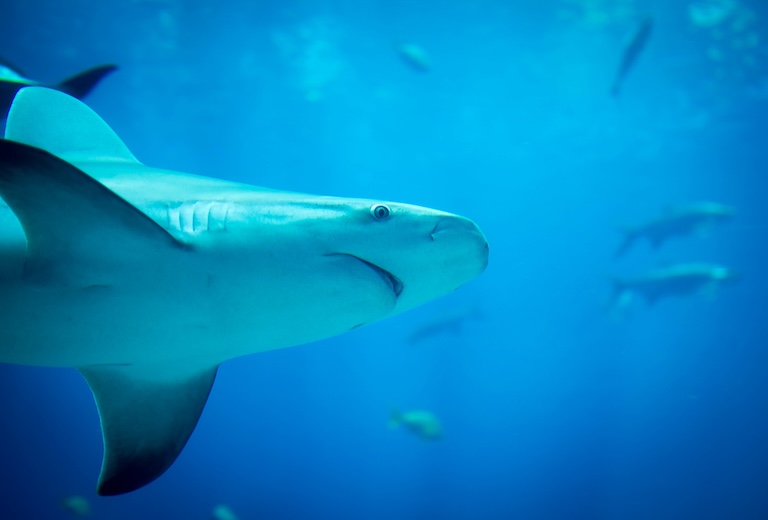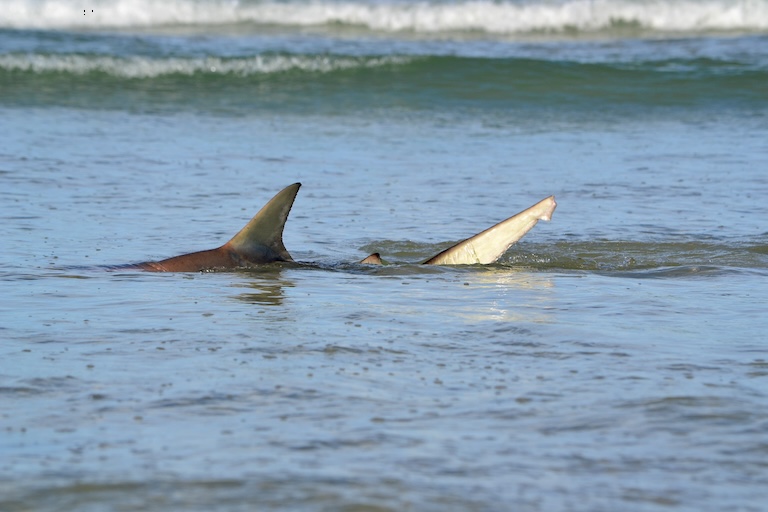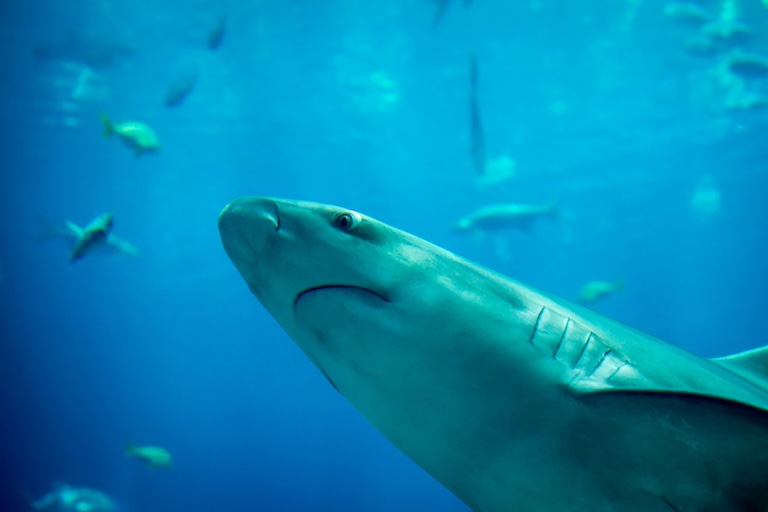Spinner Shark Profile
Requiem sharks are the best sharks. Intelligent, curvy, great sense of humour. This is the family that’s home to the graceful sharks, blue sharks, black tips, Galapagos sharks and plenty of other supermodel shark species.
Requiem sharks are fast, sleek and agile predators, like the cats of the ocean, except unlike cats, they’re not fussy about what they eat. Of the 59 species, perhaps none are more athletic than the spinner shark, who, as the name suggests, is a bit of a dancer.

Spinner Shark Facts Overview
| Habitat: | Coastal marine |
| Location: | Tropical and temperate waters worldwide |
| Lifespan: | 20+ years |
| Size: | Up to 3m (10ft) long |
| Weight: | Up to 90kg (198 lb) |
| Colour: | Silvery grey with black tips on fins, countershaded |
| Diet: | Mostly bony fish, some rays, cephalopods |
| Predators: | Probably larger sharks |
| Top Speed: | Fast, but exact speed unknown |
| No. of Species: | 1 |
| Conservation Status: | Vulnerable (IUCN) |
Spinner sharks are medium-sized requiem sharks from coastal waters all over the world. They travel long distances for food, which they exploit using a bizarre Taz-like attack in which they spin around snapping at anything and everything. This spin takes them out of the water and occasionally creates awesome shows for spectators.
They’re mostly solitary and slow to reproduce, and this has likely contributed to their decline. While they have no interest in eating people, they are responsible for a certain number of bites each year.
Interesting Spinner Shark Facts
1. They’re requiem sharks!
Spinner sharks have the characteristic sleek build and speedy disposition of the other requiem sharks, as well as giving birth to live young.
They differ from some in this order in the way their teeth are formed. Compared with the blacktip, for example – a shark that looks very similar – spinners have much narrower teeth. This is a product of the different food they eat and the way they eat it.
Spinners tend to go for bony fish and ones that are small enough to swallow whole. And they catch them in a very unusual fashion.
2. They spin
The lack of cutting edges on this shark’s teeth means that they are reduced to hunting smaller prey fish, and they do this by furiously lunging at schools of them, snapping wildly and spinning around.
This odd spinning attack is rarely seen in other species, though to further confuse the matter, blacktips copy the strategy occasionally.
Spinners hunt at night or during the low-light hours, presumably so that the other fish don’t laugh at the way they hunt. Spinning attacks carry so much momentum, that the sharks are often seen flying out of the water, still in mid-spin.
They can complete up to three more spins in the air before crashing back down. 1
3. They’re mostly solitary
Hunting is one of the times when this species will gather in large groups, but this isn’t their day-to-day. In general, they’re solitary and always on the move.
Many populations are migratory, and come into shore during feeding and mating excursions but are travelling between zones for the rest of the year. Populations in Mexico migrate to the Southernmost part of Brazil during Winter, following the warmer waters. 2

4. But they congregate around fishing vessels
When food is plentiful, these sharks come together to hunt, as previously described. They are said to come together in large numbers around commercial shrimp vessels, which can get them into some trouble.
If they’re smart, they wait patiently for the leftover catch, but they’re also known to participate in feeding frenzies and can get tangled in nets as bycatch. Over half of the sharks pulled onto prawn trawlers are dead by the time they are found.
5. They’re slow to reproduce
This species is also targeted directly, and being a coastal species, both commercial and recreational fishing contributes to their decline.
But one of this species’ vulnerabilities is its slow reproductive rate. Adult spinners might not reproduce until they are 14-17 years old, meaning they have to survive for a very long time before they can help repopulate their species.
6. And they’re in decline
Another problem with spinner statistics is the misidentification of the species. Being so similar to Blacktips means that numbers are likely badly reported all over the world, so it’s hard to know what kind of condition their populations are truly in.
What is known is that the species is now Vulnerable and in decline. They come up in bycatch worldwide, in trawls, nets and longlines, and particularly on the African coast, this species is vulnerable to unregulated small-scale exploitation.
Australia seems to be a lot better at protecting their marine fauna in general, and as such, spinner juveniles seem to be relatively safe there, but it’s far from perfect, and over-exploitation of the adults I impacting their success.

7. They can bite
Spinners don’t go for people. Their tiny teeth and need to swallow their prey whole means that they would turn their nose up at something as blubbery as a human. So, they’re not typically aggressive towards people but they are common list items on stats relating to shark bites, nonetheless.
The International Shark Attack File has recorded 16 unprovoked bites on humans, none of which resulted in death, and many of which sound a bit suspicious.
But, with so few marine biologists getting bitten by sharks, the accuracy of these reports can be dubious. For reference, blacktips are credited for more than twice as many, and none fatal.
It’s important to note that the definition of “unprovoked” always seems to mean “from the perspective of the victim”, and thus isn’t entirely useful. A surfer may not consider their activities provocative, but to a great white, it’s essentially like dragging a toy mouse in front of a hungry cat: pretty provocative.
Likewise, it’s not clear whether unprovoked attacks on divers include those that come as collateral damage from a feeding frenzy instigated by those divers. 3
Spinner Shark Fact-File Summary
Scientific Classification
| Kingdom: | Animalia |
| Phylum: | Chordata |
| Class: | Chondrichthyes |
| Order: | Carcharhiniformes |
| Family: | Carcharhinidae |
| Genus: | Carcharhinus |
| Species: | Brevipinna |
Fact Sources & References
- Storyful Viral (2021), “Spinner Sharks Put On ‘Awesome’ Display for North Carolina Fishermen”, YouTube.
- “Spinner Shark”, IUCN Red List.
- “Spinner Sharks, Carcharhinus brevipinna”, Marine Bio.
